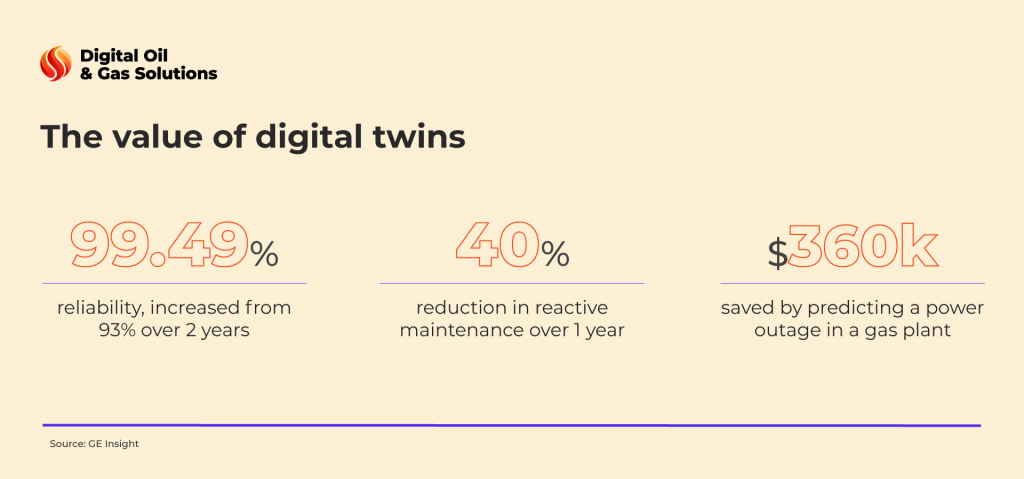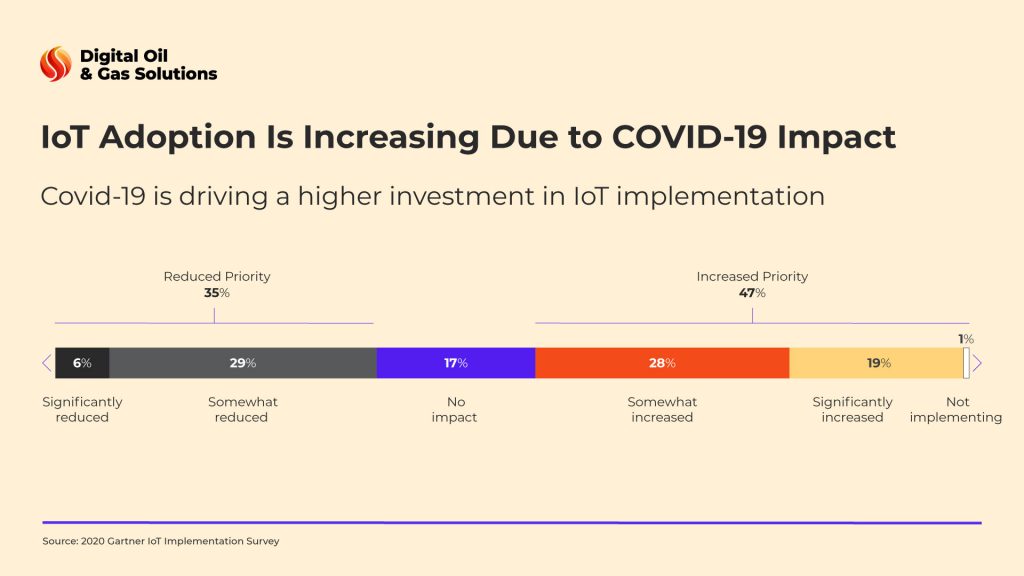The state of the intelligent oil and gas market
It’s not a secret that the oil and gas industry has been encountering obstacles primarily due to obsolete methods used to manage assets and accumulate data. Since most still collect information manually through conventional infrastructure pigging, the process turns out to be expensive, tedious, and error prone. However, despite disrupted revenues and changed labor patterns, meaningful possibilities of employing digital technologies have emerged. As a result, business leaders have already future-proofed their value chains with a solid integration of crossed systems and asset ecosystems.
Today, oil and gas companies using business process improvement practices constantly analyze their operations to identify inefficiencies and address them immediately. The growing application of digital twins and IoT for oil and gas advancements is one of the examples since they assist management teams in reducing costs and making informed decisions. Below we’ll talk about other distinct ways IoT and having a digital twin in oil and gas will serve any company in the industry.
Benefits of IoT in oil and gas combined with digital twins
Oil and gas processing improvements have a lot to do with the employment of IoT technologies. Apart from such benefits of IoT in oil and gas as preventive equipment maintenance, remote machinery inspection, and real-time tanker fleet tracking, digital twin (DT) also contributes to workers’ security and advanced data analytics. Since these technologies often go hand in hand, let’s dive a little deeper into some of the essential benefits you can count on.
- Discover new drilling sites
Individual IoT sensors can help you scan subsurface sites, discover potential drilling areas, and maximize operating site production. A seismic sensor network connected to the internet can collect immense amounts of data while generating a comprehensive view of a subsurface location. Then, once a comparable data analysis is performed, an optimum drilling location is selected. Consequently, the use of IoT in oil and gas increases the productivity of new and current drilling rigs while decreasing the time necessary for site-selection data processing. - Allow remote machinery inspection
An IoT-enabled digital twin in oil and gas also offers significant advantages in remote monitoring and maintenance. Smart sensors transfer metrics and other information to a cloud platform, thus enabling real-time monitoring of even the most distant assets. As a result, companies can get a clear and accurate picture of how each asset is functioning by using remote connectivity. Practically, you can access these statistics anytime and anywhere, facilitating your operations, allowing you to make timely decisions, and preventing employees’ exposure to dangerous environments. - Provide real-time insights
Digital twin technology is a more progressive and convenient way to check live data. Recently it has been quickly gaining ground as more industrial IoT devices have become integrated into massive systems. Past and current data can be added to digital infrastructure replicas to improve visibility, decision accuracy, and working algorithms. For example, the system can notify managers about low oil levels, help them track barrel storage, and monitor tank health. All this information allows leadership to initiate and drive changes that will have the most beneficial effects on business and industry in general. - Prevent unnecessary equipment maintenance
By creating a digital replica of a physical item, business leaders can visualize maintenance duties and later view virtual models on computers or mobile devices to assess the status, performance, and record of the physical asset. Moreover, digital twins allow making adjustments and amendments without having to touch the physical asset. So, before performing any work on the asset, organizations can determine the correct amount of intervention and preventive maintenance required to optimize its performance and maximize its lifespan. Additionally, when DT is underpinned by centralized data collection equipment that runs in parallel with a rig’s network, companies can get alerts about potential maintenance difficulties and solve them immediately. - Reduce downtime cost
As companies adjust to new business models driven by COVID-19, many are employing technology to improve their business resilience. Implementing IoT and digital twin in offshore oil and gas projects in the North Sea, for example, resulted in project cost reductions of over 2 million euros for assets with topsides of 10,000 tons. Meanwhile, smart technologies are projected to save oil and gas operators between 9% and 15% on total decommissioning project costs.
In fact, the use of predictive maintenance analytics based on past data enables leaders to predict the breakdown of a critical component of an offshore oil platform and schedule preventive maintenance, saving them weeks of unplanned downtime and lost production costs. So, it’s hardly surprising that businesses have started implementing these technologies to improve situational awareness and automate corporate response to dynamic situations. Overall, there are plenty of ways how the Internet of Things can save oil and gas money.

Ensuring wells fail-safe performances
Digital twins are being implemented across businesses to improve security, decrease downtime, and comply with COVID regulations among other things. Meanwhile, industrial IoT in oil and gas can be used at every stage of the supply chain. For example, it assists network operators in planning and executing projects, drilling the next well, and constructing new assets more efficiently.
Businesses can use these technologies to test operating procedures and capital investments in a virtual environment before applying them in the real world. Eni, as an example, is utilizing digital twins to produce virtual copies of its wells in difficult operational situations to evaluate the impact of choices in a secure setting. Petrobras, on the other hand, has implemented this technology in 11 of its refineries, allowing it to assess and adjust operating parameters in near real-time. What’s important is that they were able to save about $154 million. In addition, digital twins are also employed for an operational replay of actual field activities, simulation of existing facilities’ inspections, and enhanced safety exercises training.
With world-class monitoring solutions able to advance your systems with the most remarkable features of cloud computing, smart field operations are now guaranteed. As a result, business owners can get a robust IT system that incorporates well management, maintenance, and field data capture services while saving an enormous amount of money on operating costs.

Improved business decisions following COVID-19
In reality, the oil and gas industry has been hesitant to embrace IoT-based digital twins. As a result, only a few large corporations have experienced the benefits of IoT in oil and gas having already started investing in innovation. However, a Gartner survey predicts that by 2023 47% of enterprises will increase their capital expenditures in IoT. It also states that due to the pandemic, 31% of businesses will employ digital twins to enhance employee and customer safety by minimizing in-person monitoring. So, we can say that embracing IoT technologies will provide business leaders with the tools and data necessary to analyze market decisions and thrive in the long run.
With this notable process improvement, oil and gas operations will become critical, especially for companies dealing with unpredictable and uncertain market conditions in the industry. To be better prepared and ready to predict asset failures while saving costs, companies need to seriously consider the adoption of the latest technologies. We would be glad to guide you through your digital transformation journey, reach out to us and let us tailor effective solutions for your company.






